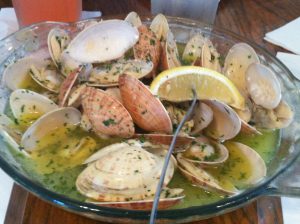
Shellfish aquaculture is a relatively new pursuit in Florida. It began in the 1970s in the Indian River Lagoon when attempts were made to culture hard clams as a means of taking pressure off declining wild populations. Techniques for producing seed clams had been developed 20 years prior and Harbor Branch Oceanographic Institution (HBOI) developed early grow-out technologies based on culture methods already used in the Northeast but modified for Florida’s subtropical and subtidal conditions.
These early efforts got a major boost in the early 1990s as a result of federally-funded job retraining programs designed to provide employment opportunities for displaced workers from the commercial fishing industry. The most notable retraining program began in 1994 when the gill net ban took effect.
In 1995 a position was created within UF-IFAS Extension to assist the emergent shellfish aquaculture industry on Florida’s west coast and that position later expanded to allow for statewide extension activities. Through the efforts of HBOI, UF, Florida Sea Grant, and many others, over 350 program graduates were trained and placed onto shellfish aquaculture leases of 2-4 acres. These entities continue to support this industry through integrated research, education and extension activities today.
Here in the early days Dan Leonard, who had a lease originally in Bull Bay, was the project manager for the retraining programs in Charlotte and Lee Counties with an office in Placida. These programs resulted in about 90 graduates. Tony Heeb, who is still in growing clams today, was also employed by HBOI as a technician and ran a shellfish nursery that was set up in Bokeelia.
In southwest Florida, aquaculture lease sites are established in Gasparilla Sound behind Sandfly Key, in Pine Island Sound near Demere Key, and inside Bull Bay. Over 50 leases in our area are actively farmed today but many of the faces have changed since the 1990s. Tending to crops is very different from fishing. Those that adapted to the farming lifestyle survived but many moved on to other things. Only a few of the original Pine Island Sound farmers maintain their leases, otherwise those practicing shellfish aquaculture today are new.
Successful clam farming requires good, clean water, free from contamination. Water quality and periodic red tide blooms produce the biggest challenges for southwest Florida clam farmers. Clam farmers are hardworking, business savvy, and actively involved in the regulatory and seafood safety aspects of the business. They have to be. To make a profit and keep their business alive, they need to ensure their product is safe for consumers. Florida enforces strict safety protocols for molluscan shellfish to ensure consumers are getting a safe product. In Florida clam farmers must sell to a Certified Shellfish Dealer.
Successful clam farmers also need to be innovators. As one told me “necessity is the mother of invention.” And that is absolutely true. Growing conditions are very different from region to region. Here clam leases are in water deeper than other farmed areas of the state. As a result special dive gear and harvesting methods are necessary. Who better to develop or tweak tools of the trade for local conditions than those who will benefit the most?
Up until recently shellfish aquaculture in Florida consisted solely of hard clams, but new crops such as sunray venus clams and oysters are coming online and others are being evaluated. Clam farmers in southwest Florida are particularly excited about sunray venus clams, a species that naturally grows here and is thus well suited for growing in this area.
You might ask, where do all of these raised clams go? Although dated, a 1999 report indicated that the southwest Florida industry sold more than half of their product to buyers outside of the state (55 percent), 39 percent to other regions in Florida, and only 6% locally. A 2009 report aggregated southwest Florida with east Florida. Those results indicated that the majority of clams were sold to other wholesale dealers, followed by retailers, followed by restaurant buyers and final consumers. According to local farmer and producer Barry Hurt, most of the clams produced here today stay in southwest Florida.
How important is this industry in Florida? Here are some 2015 stats. These numbers are not available by region (and it is important to note the bulk of clam farming in Florida occurs in Cedar Key), but here goes: in 2015, 1,548 acres of submerged land were leased from the State of Florida for shellfish aquaculture, 288 farmers worked these leases, 543 jobs were supported by aquaculture, 136 million clams were produced, sales by dealer totaled $19.6 million, with a total economic impact to Florida estimated at $38.7 million.
Aquaculture leases in Florida are managed by the Division of Aquaculture within the Florida Department of Agriculture and Consumer Services. Leases are ten-year term and renewable with annual fees based on the size of the lease. New leases can be requested through an application process.
Hurt, B. and C. Hemmel. 2016. Personal and email communication.
Sturmer, L. 2016. Email communication.
Shellfish aquaculture online resource guide. 2016. http://shellfish.ifas.ufl.edu/
Florida Sea Grant. 2015. Florida’s Economy is Expanding Under the Sea, factsheet 2pp.
 0
0
